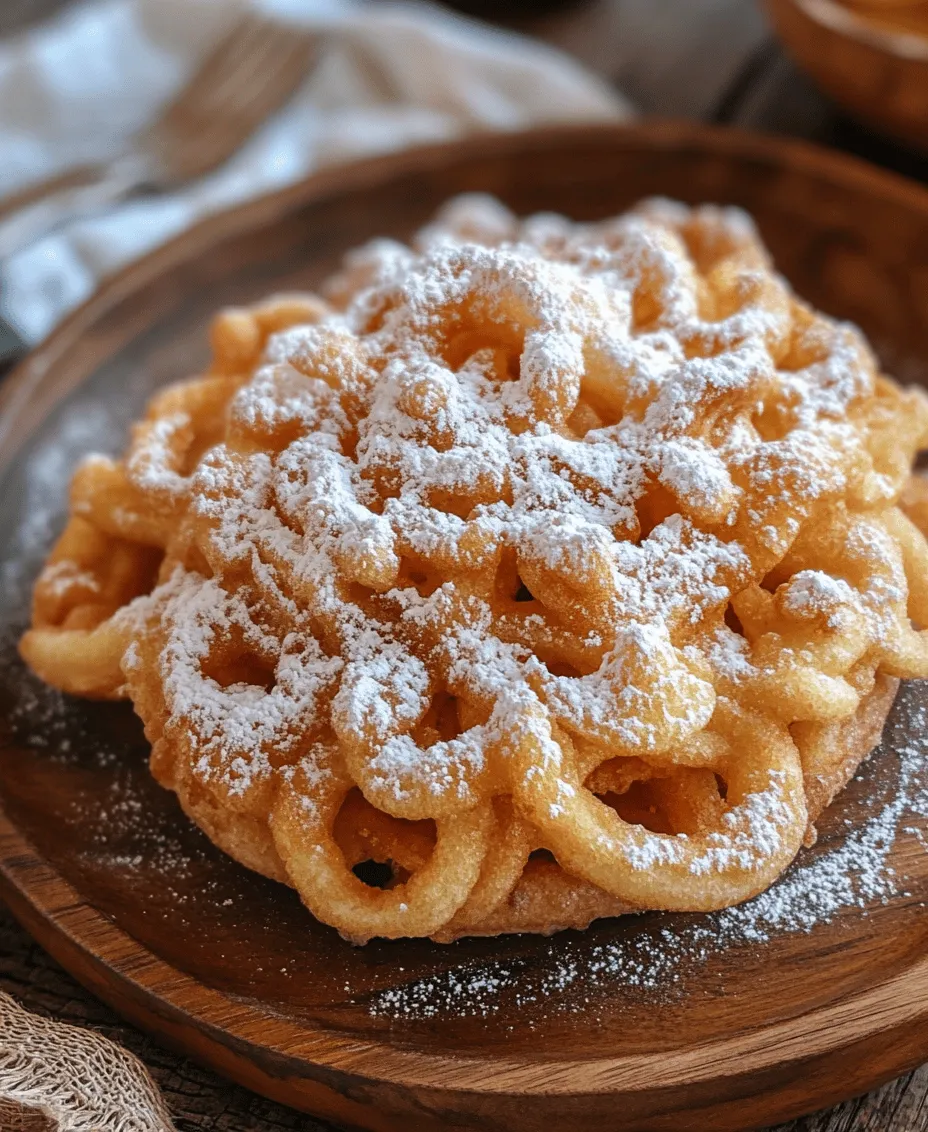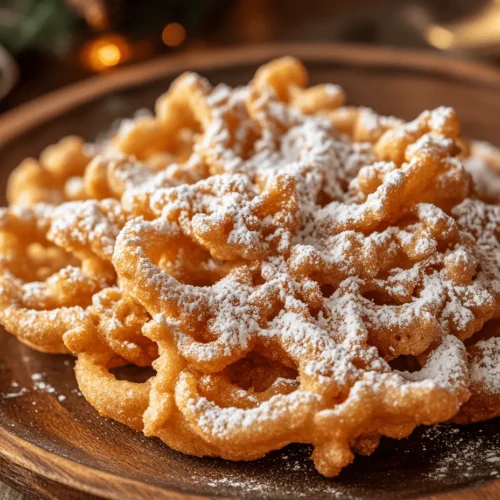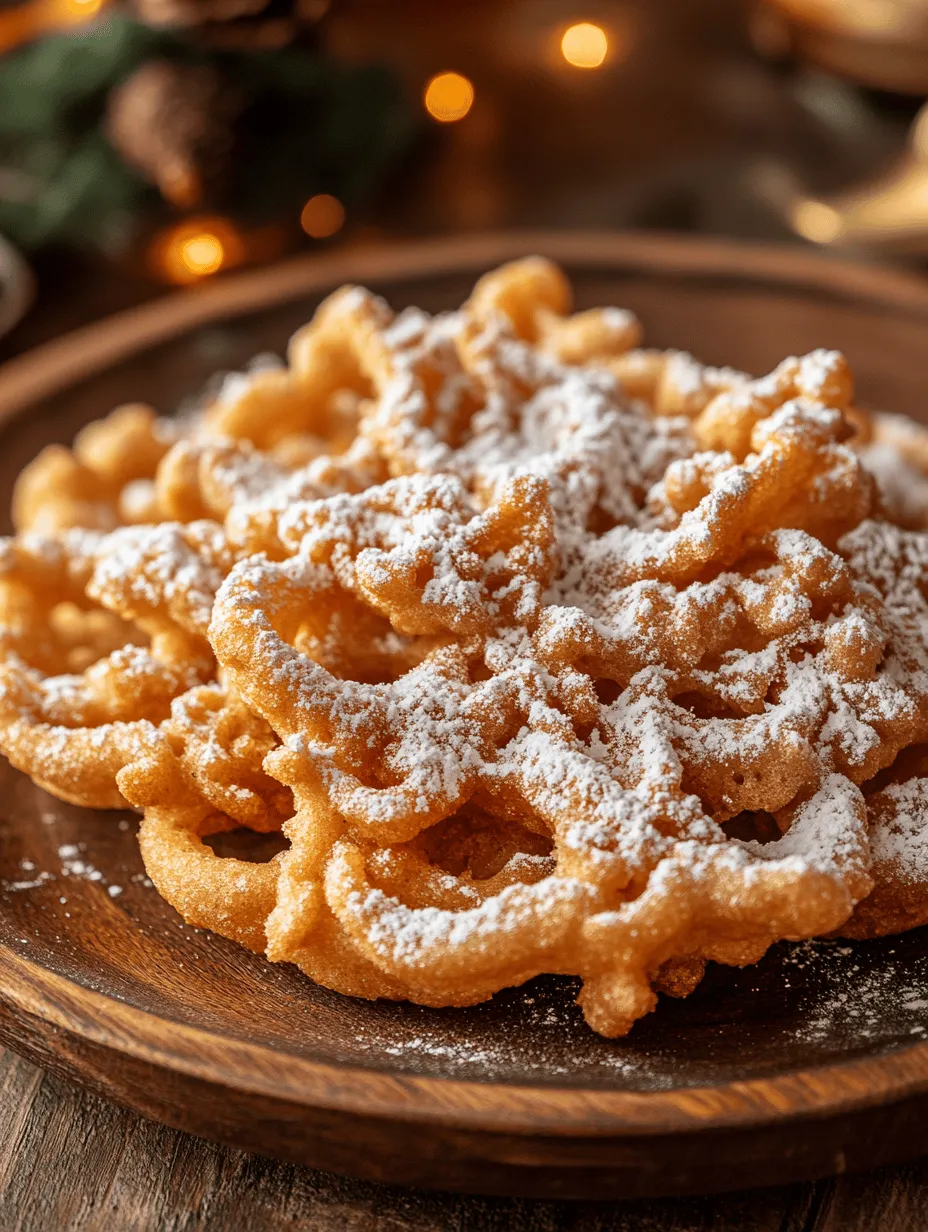Funnel cake is more than just a dessert; it’s a nostalgic symbol of summer fairs and festivals, evoking the laughter of children, the thrill of carnival rides, and the sweet aroma of fried dough wafting through the air. This easy-to-follow Funnel Cake Fiesta recipe allows you to recreate this iconic treat in your own kitchen, bringing the joy of the fair straight to your dining table. Whether you’re hosting a family gathering, planning a backyard BBQ, or simply indulging a sweet tooth, this recipe is sure to impress.
In this article, we will explore the delightful history and significance of funnel cake, provide detailed step-by-step instructions to make your own crispy, sugary indulgence, and share tips to ensure a perfect golden-brown finish. Let’s dive into the world of funnel cake and discover how to make this beloved treat!
The Origins and Cultural Significance of Funnel Cake
A Brief History of Funnel Cake
The story of funnel cake dates back to medieval Europe, where similar fried dough confections were being enjoyed. Known as “Strauben” in Germany, these crispy delights were made from a simple batter and fried until golden, often enjoyed during festivals and fairs. The tradition of frying dough and sprinkling it with sugar was carried over to America by German immigrants in the 19th century, where it quickly became a staple at county fairs and local festivals.
In the United States, funnel cake has evolved into a beloved treat, often found at amusement parks, carnivals, and state fairs. Its signature shape—a web of fried batter—makes it not only delicious but visually appealing, creating an irresistible temptation for fairgoers. The first recorded mention of funnel cake in America dates back to the 1930s, but its popularity has remained steadfast, solidifying its place in American culinary culture.
Funnel Cake Around the World
Funnel cake is not the only fried dough dessert enjoyed around the globe. Many cultures have their own versions, showcasing the universal appeal of fried dough. For instance, in Spain, churros are long, ridged pastries, often served with a side of chocolate dipping sauce. Italy boasts zeppole, which are light and fluffy dough balls, typically dusted with powdered sugar and enjoyed during celebrations. Similarly, in the Middle East, you can find “zalabia,” which are syrup-soaked fried dough balls that delight with their sweetness.
Each variation shares a common theme: the joy of indulging in crispy, fried dough. These desserts transcend borders, connecting people through the simple pleasure of good food. Funnel cake, with its unique shape and texture, has carved out its niche in the American culinary landscape, inviting everyone to experience a taste of nostalgia.
Ingredients for Funnel Cake Fiesta
To create the perfect funnel cake, you will need a few essential ingredients. Understanding the role of each component will help you achieve the best results.
Essential Ingredients
1. All-Purpose Flour: This is the backbone of your funnel cake batter. It provides structure and stability, allowing the cake to hold its shape while frying. The gluten in all-purpose flour also contributes to the desired texture—light yet slightly chewy.
2. Granulated Sugar: Sugar is crucial for sweetness and contributes to the caramelization process when frying. This caramelization creates that delightful golden-brown color and adds a rich flavor to the funnel cake.
3. Baking Powder: This leavening agent helps the batter rise as it fries, giving the funnel cake its fluffy texture. Without baking powder, your funnel cake may turn out dense and heavy.
4. Salt: A pinch of salt enhances the overall flavor of the funnel cake, balancing the sweetness and bringing out the other ingredients.
5. Milk: Milk adds moisture to the batter, creating a smooth consistency. It also helps with browning during frying, contributing to that perfect golden finish.
6. Eggs: Eggs act as a binding agent in the batter, adding richness and helping the cake achieve a tender crumb.
7. Vegetable Oil: This is essential for frying. Choosing a high-smoke point oil like vegetable or canola oil will prevent the oil from burning while cooking the batter.
Optional Additions and Variations
While the classic funnel cake is delightful on its own, you can elevate it further with a few optional ingredients and toppings:
– Flavoring the Batter: Consider adding spices like cinnamon or nutmeg for a warm, aromatic flavor. A splash of vanilla extract can also enhance the sweetness and provide a lovely aroma.
– Toppings: The traditional topping for funnel cake is a generous dusting of powdered sugar. However, you can get creative with your toppings. Drizzle chocolate sauce or caramel over the top, add fresh fruits like strawberries or bananas, or a dollop of whipped cream to create a decadent dessert.
With a few simple ingredients and optional variations, you can customize your funnel cake to suit your taste and make it a truly memorable treat.
Step-by-Step Instructions for Making Funnel Cake
Now that you have a clear understanding of the ingredients, it’s time to roll up your sleeves and start making your Funnel Cake Fiesta! Follow these step-by-step instructions to create your own batch of delicious funnel cakes.
Preparing the Batter
1. Gather Your Ingredients: Before you start, ensure that you have all your ingredients measured and ready to go. This will make the process smoother and prevent any last-minute scrambling.
2. Mix Dry Ingredients: In a large mixing bowl, whisk together 2 cups of all-purpose flour, 2 tablespoons of granulated sugar, 1 tablespoon of baking powder, and a pinch of salt. Make sure there are no lumps in the mixture, as they can affect the texture of your funnel cake.
3. Combine Wet Ingredients: In a separate bowl, whisk together 1 cup of milk and 2 large eggs until well combined. This mixture should be smooth and slightly frothy.
4. Combine Dry and Wet Mixtures: Gradually pour the wet mixture into the dry ingredients while stirring continuously. Mix until just combined; the batter should be thick but pourable. Avoid overmixing, as this can lead to tough funnel cakes.
5. Heat the Oil: In a deep skillet or heavy-bottomed pot, pour enough vegetable oil to reach a depth of about 2 inches. Heat the oil over medium-high heat until it reaches a temperature of 350°F (175°C). You can test the oil by dropping a small amount of batter into it—if it sizzles and rises to the surface, the oil is hot enough.
This marks the beginning of your funnel cake journey, setting the stage for frying and creating that iconic crispy texture. As you prepare to fry, remember to be safe and mindful of hot oil to avoid any accidents. In the following steps, we’ll guide you through the frying process and how to achieve that beautiful golden-brown finish, making your Funnel Cake Fiesta a delightful success.

Detailed Instructions on Mixing Dry and Wet Ingredients
To create the perfect Funnel Cake Fiesta, begin by preparing your dry ingredients. In a large mixing bowl, combine 2 cups of all-purpose flour, 1 tablespoon of baking powder, 1/2 teaspoon of salt, and 1/4 cup of granulated sugar. Whisk these ingredients together thoroughly to ensure an even distribution of the baking powder and salt, which are essential for achieving that light, airy texture.
Next, it’s time to prepare the wet ingredients. In a separate bowl, beat 2 large eggs and add 1 cup of milk. For an extra touch of flavor, consider adding 1 teaspoon of vanilla extract. Mix these wet ingredients until they are fully combined and slightly frothy. This aeration will help your batter become lighter and contribute to the overall fluffiness of the funnel cake.
Once both mixtures are ready, it’s crucial to combine them efficiently. Pour the wet mixture into the bowl of dry ingredients gradually, stirring continuously with a whisk or wooden spoon. The goal is to incorporate the wet and dry components without overmixing. A smooth, lump-free batter is essential; it should have a pourable consistency, similar to that of pancake batter. If you notice any lumps, gently break them down, but remember that a few small lumps are acceptable. Overmixing can introduce too much air into the batter, which can lead to undesirable texture during frying.
Mastering the Frying Technique
The frying process is where your funnel cake transforms from batter to a delicious treat. The first step is ensuring that you heat the oil to the correct temperature. Use a deep-frying thermometer to monitor the oil, aiming for a temperature between 350°F and 375°F (175°C to 190°C). This range is essential because oil that is too hot can cause the funnel cakes to burn on the outside while remaining raw on the inside, while oil that is not hot enough will result in greasy, soggy cakes.
To create the iconic spiral shape when frying, you can use a squeeze bottle or a funnel with a narrow opening. Fill your chosen tool with batter, and when the oil is ready, carefully squeeze or pour the batter into the hot oil in a circular motion, starting from the center and working outward. Continue to spiral around until you have formed a full circle, then create a second layer by crossing over the first. This method not only adds aesthetic appeal but also ensures that each piece has a balanced texture and flavor.
Frying and Draining
Once the batter is in the oil, it’s important to monitor the frying time closely. Fry each funnel cake for about 2-3 minutes on one side, until it turns a golden brown color. Using a slotted spoon or tongs, gently flip the cake over to cook the other side for an additional 1-2 minutes. Achieving a uniform coloration is key to ensuring that the cake is cooked through but not burnt.
After frying, the next crucial step is to drain the excess oil. Place the cooked funnel cakes on a plate lined with paper towels to absorb any residual oil. This step is vital for maintaining the crispiness of the funnel cake. Avoid stacking the cakes on top of each other while they are still hot, as this can trap steam and moisture, leading to a soggy texture.
Serving Suggestions for Funnel Cake Fiesta
Traditional Serving Styles
The classic way to serve funnel cake is with a generous dusting of powdered sugar. This not only adds sweetness but also enhances the visual appeal of the dessert. For a simple yet delightful experience, serve the funnel cakes warm, straight from the fryer, with a light sprinkle of powdered sugar on top.
Additionally, consider offering a side of fresh fruit or dipping sauces. Fresh berries, sliced strawberries, or bananas can provide a refreshing contrast to the sweetness of the cake. For those who prefer a more indulgent experience, sauces like chocolate syrup, caramel, or even a rich cream cheese frosting can elevate your funnel cake to new heights.
Creative Serving Ideas
For those looking to experiment, funnel cake can be transformed into a fun dessert sandwich. Take two pieces of funnel cake and fill them with a scoop of your favorite ice cream. This whimsical creation is perfect for hot summer days and will surely impress your guests.
Alternatively, consider savory variations of funnel cake. Incorporate shredded cheese or fresh herbs into the batter for a unique twist. These savory funnel cakes can be served as appetizers or snacks, making them a versatile addition to any gathering.
Nutritional Information for Funnel Cake
When indulging in homemade funnel cake, it’s essential to be aware of the nutritional content. A typical serving of funnel cake contains approximately 300-400 calories, depending on the size and toppings. The breakdown generally includes around 20 grams of fat, 50 grams of carbohydrates, and 15-20 grams of sugar.
While funnel cake is undeniably an indulgent treat, moderation is key. Enjoying it as an occasional dessert can be part of a balanced diet. Pair it with fresh fruit or a side of yogurt to increase its nutritional value while still relishing the sweet flavors.
Conclusion
The Funnel Cake Fiesta recipe offers a delightful way to bring the carnival experience into your home, bringing joy to family and friends alike. With its rich history and cultural significance, funnel cake remains a beloved indulgence that transcends generations. By following the detailed instructions provided in this guide, you can master the art of making funnel cakes, ensuring they are crispy on the outside and fluffy on the inside.
Whether you choose to serve them traditionally with powdered sugar or explore creative variations, funnel cakes are sure to create memorable moments. Embrace the joy of homemade funnel cakes, and savor the sweet moments that come with them. So gather your ingredients, heat up that oil, and let the Funnel Cake Fiesta begin!


